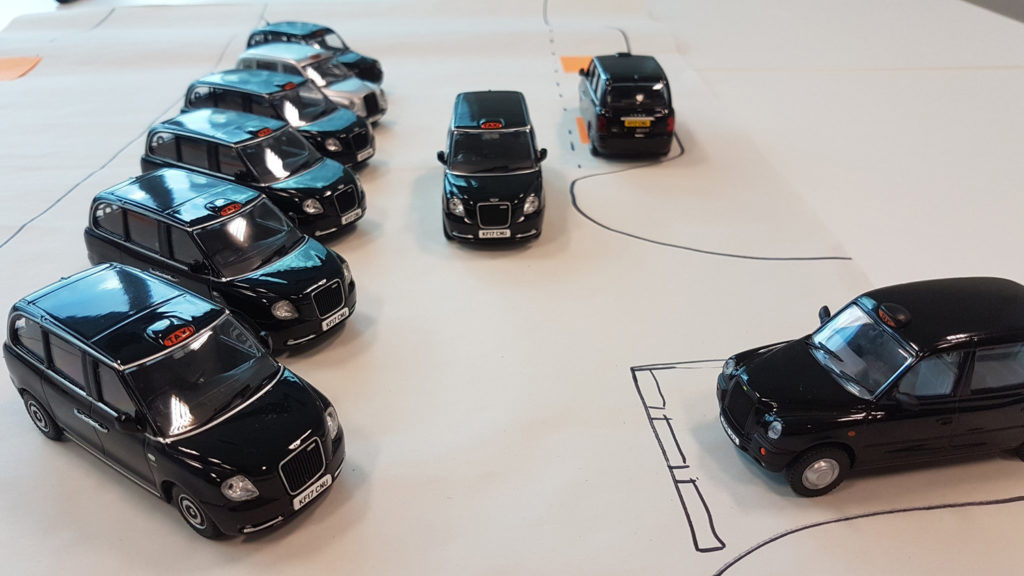
I was working for a project developing innovative charging facilities to solve the shortage of charging stations for electric taxis. Partners included Transport for London (TfL), Nottingham City Council (NCC) and Shell.
Road transport is responsible for about one third of greenhouse gasses, therefore a shift to electric vehicles has the potential to reduce the environmental damage caused by road transport. But the adoption of electric vehicles faces several challenges, for example the lack of charging facilities, long charging times, limited range and inconvenience of cable charging. These barriers are certainly more pronounced for taxis, as they generally cover longer mileages per day than regular cars. They also have fewer opportunities for recharging as they do not remain parked for long hours during the day.
Wireless charging is the method of transferring energy at distance without wires. It has been available for portable electronic devices such as smartphones, watches and headphones for some time. Recent developments are providing enough power to charge large vehicles.
The project
To try to minimise these barriers, a feasibility project was formed, funded by Innovate UK and industry partners. This project was set to evaluate the proposition of wireless charging, and the main objective was to inform the design of this technology. Requirements ranged from the hardware design to where to install them.
Qualitative data analysis from conversations with stakeholders provided impressions, preferences and recommendations to this project. Staff working for the public sector including their regulatory bodies gave useful information to better design such systems. Quantitative data from tracking of vehicles indicated the preferred areas of the cities down to the ideal road and precise location to install these chargers.

Strengths and weaknesses
One key advantage over the conventional cable charging is that the driver doesn’t need to step out of the car and plug in a cable, in order to begin the charging process. Wireless chargers can also be placed on or below road surfaces, doesn’t create a tripping hazard, and doesn’t occupy space on the pavement. Therefore, it enables installation where cabled charging is not physically be possible. Conservation areas and pedestrian access limit the locations available for cable charging, making wireless charging an option in city centres.
One limitation is the need to park the vehicles exactly over a specific position to align the charging pads and optimise charge. Another weakness is the small power transfer, similar to a slow home charger, to prevent overheating the pads.

My activities
I performed a combination of interviews and focus groups with drivers and local authority representatives to provide an understanding of facilitators and barriers to the introduction of these wireless chargers. The locations of this research were in central London and Nottingham, UK. I was responsible for recruiting and arranging places to host the interviews or focus groups, intermediated by TfL and NCC. I conducted these interviews and focus groups, collecting all data. I transcribed interviews, analysed data, created qualitative themes and wrote the reports and one academic publication (details below).

Results show that most drivers required recharging instances during working hours, causing longer shifts and/or lower earnings. Drivers reported running on petrol once the battery is depleted, negating or limiting the environmental benefits of electric taxis. Even though the power transfer is limited, we conclude that wireless chargers can increase the range of existing taxis if these are installed where drivers stop more often, for example within the taxi ranks. It’s possible to provide opportunistic, short but frequent charging boosts (known as choko-choko) so taxi drivers don’t have to detour and park the car by a cabled charger.
WiCET in the news
The WiCET project was featured on BBC News, when researchers demonstrated the wireless charger to the TV crew. The video was published on LinkedIn here.
Publication
The full details of this study, including a thorough literature review containing 99 items, the methodology, quantitative and qualitative data analysis including quotes from participants, and discussions of results can be accessed in the academic publication produced at the end of this project. The open access journal article is now available for free online, published in the peer-reviewed journal Sustainability.
Oliveira, Luis; Ulahannan, Arun; Knight, Matthew; Birrell, Stewart. Wireless Charging of Electric Taxis: Understanding the Facilitators and Barriers to Its Introduction. Sustainability 2020, 12, 8798.
Available at https://www.mdpi.com/2071-1050/12/21/8798
Impact
We concluded that the wireless charging of electric taxis is feasible, so the partners took our recommendations forward for further test and real-world implementation. We suggested one specific location, outside the main train station in Nottingham, to work as the feasibility demonstrator of the technology. This subsequent project incorporated the recommendations provided by my contribution to this my research. More information on the project website https://wicet.co.uk/.
